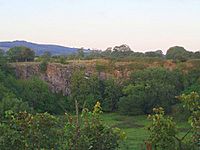Windsor Hill Quarry facts for kids
| Site of Special Scientific Interest | |
 |
|
| Area of Search | Somerset |
|---|---|
| Coordinates | 51°12′14″N 2°33′09″W / 51.20381°N 2.55246°W |
| Interest | Geological |
| Area | 0.8 hectares (0.0080 km2; 0.0031 sq mi) |
| Notification | 1971 |
Windsor Hill Quarry is a special place in Somerset, England. It's a 0.8 hectare area, which is about the size of one international rugby field. This site is important for its geology, meaning it helps us learn about the Earth's history through rocks and fossils. It's located near Shepton Mallet on the Mendip Hills. Right next to it is another special area called Windsor Hill Marsh, which is important for its plants and animals. Windsor Hill Quarry was officially recognized as a special site in 1971.
Contents
What is a Site of Special Scientific Interest?
A Site of Special Scientific Interest (SSSI) is a protected area in the United Kingdom. These places are chosen because they have important wildlife, plants, or geological features. Protecting them helps make sure these special parts of nature are kept safe for the future. Windsor Hill Quarry is a geological SSSI because of the amazing fossils found there.
Digging Up the Past
Windsor Hill Quarry is a very important place for studying ancient animals. Scientists have found fossils here that help us understand life from millions of years ago. It's part of something called the Geological Conservation Review, which identifies the best places in Britain for studying geology.
Who was Oligokyphus?
One of the most exciting discoveries at Windsor Hill Quarry was fossils of a creature called Oligokyphus. This animal was a type of tritylodont. Tritylodonts were ancient, reptile-like creatures that lived a very long time ago, during the time of the dinosaurs. They are interesting because they show features that are a bit like reptiles and a bit like early mammals. Finding their fossils here helps scientists learn how life on Earth changed over millions of years.
A Railway Connection
Windsor Hill Quarry is no longer used for digging up rocks. It used to be a busy place where stone was taken out of the ground. This stone was then moved using a railway. The quarry was connected to the Somerset and Dorset Joint Railway, which was a railway line that ran through Somerset and Dorset. However, the railway tracks that served the quarry were removed in 1957, and the quarry stopped being used for its original purpose.

